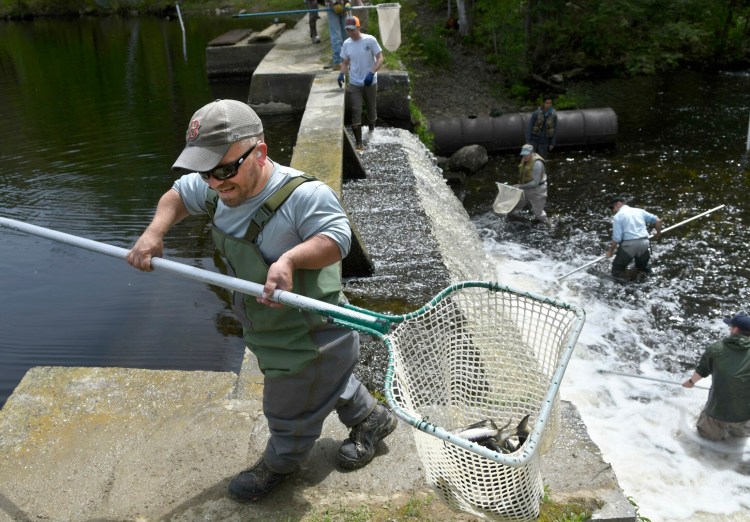CHELSEA — Togus Pond is getting a fishway six years after receiving grant funding for a design to more easily allow alewives in, a project that officials say will reduce pollution in the landmark water body that’s been classified as impaired.
The series of pools will allow alewives, a species of herring, to move to and from Togus Dam, said Sean Ledwin, director of sea-run fisheries and habitat division for the Department of Marine Resources. The pools will not affect the water level of the pond.
Without the fishway, which is due to be installed between July 1 and September, alewives were moved over the dam by hand for the last six or seven years, Ledwin said. With that method, he said, only 10,000 to 30,000 fish could be moved; when the fishway is operational, that number will be between 300,000 and 400,000.
“It is nice to get so we don’t have to lift by hand,” said Leif Erik Dahlin, community services director for Augusta.
Creating easier access for alewives to get to the pond also is expected to help reverse pollution in the body of water.
In a 2015 article, it was noted that reintroduction of alewives into Maine’s waterways had helped balance the ecosystem and clean up bodies of fresh water in central Maine. Adult alewives travel upriver from the Gulf of Maine to breed in freshwater lakes in the spring. Their spawn do the dirty work.
The increased amount of fish in the 648-acre pond will clean algae and phosphorus in the water that blocks out the oxygen and is dangerous to fish, said Greg Jolda, president of the Worromontogus Lake Association, which was created for maintenance and management of the dam.

Alewife are passed over the dam that impedes Togus Stream Tuesday in Chelsea. The sea-run herring was restored to Togus Pond as part of an anadromous fish restoration project by the state agency, with multiple partners, that will result in fish passage being erected in the dam that officials estimate is more than 200 years old. Kennebec Journal photo by Andy Molloy
Dahlin said Togus Pond is classified as impaired because of the phosphate level, and the cleaning the alewives do is site-specific. The system could be implemented at other ponds and lakes nearby, however.
The Association, in cooperation with the state and the city of Augusta, received state grant funding of $24,000 in 2013 to plan and engineer a fishway to allow fish to get behind the Togus Dam. The group has owned the stone masonry and concrete dam, originally built in 1804, since 1932. The approximately 25-foot-long and 7-foot-high dam was rebuilt in the 1980s; in 2013, it was deemed to be in good condition.
Alewives are used mainly for lobster bait, Ledwin said, and since there has been a lobster bait shortage, towns could earn money from the increased population.
They could also help the Atlantic Salmon, which are endangered fish, according to the National Oceanic and Atmospheric Administration.
The introduction of the alewives also would give cover to the Atlantic salmon, so there would be less chance of them being eaten by a predator, Jolda said. Atlantic Salmon eggs were found in the stream.
Ledwin said alewives are eaten by eagles and ospreys and even by whales in the ocean.
Funding for the project came from NOAA, which provided a $400,000 grant, Dahlin said. Another $8,000 came from the Maine Outdoor Heritage Fund, according to the Worromontogus Lake Association’s website.
“This is a huge year for the lake,” Dahlin said.

Alewife migrate Tuesday to the headwaters of Togus Stream in Chelsea. Biologists estimate that 10,000 of the sea-run herring were restored to Togus Pond as part of an anadromous fish restoration project by the state agency, with multiple partners, that will result in fish passage being erected in the dam that officials estimate is more than 200 years old. Kennebec Journal photo by Andy Molloy
Send questions/comments to the editors.



Comments are no longer available on this story